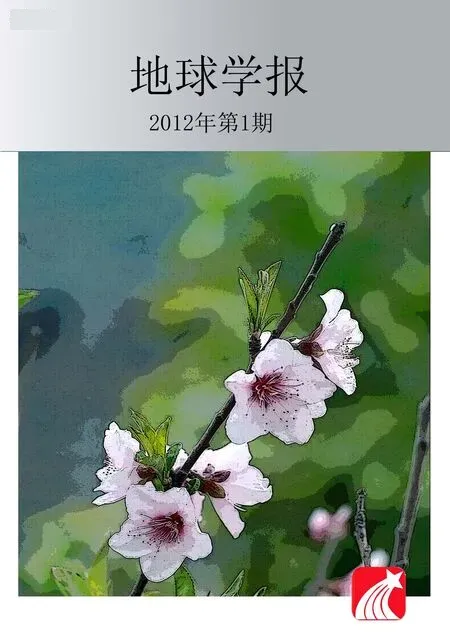泰国北部中三叠世放射虫硅质岩及其地球化学和沉积环境意义
2012-04-01HATHAITHIPTHASSANAPAK,MONGKOLUDCHACHON,CHONGPANCHONGLAKMANI
泰国北部中三叠世放射虫硅质岩及其地球化学和沉积环境意义
E-mail: bthaithip@yahoo.com.
Bedded cherts collected from northern Thailand,including Chiang Dao, Lamphun and Den Chai contain Middle Triassic radiolarian faunas. The faunas from Chiang Dao can be divided into two assemblages. The first assemblage includesEptingiumand other co-occurring species such asCryptostephanidium cornigerumDumitrică,Plafkerium antiquumSugiyama,Pseudostylosphaera compacta(Nakaseko and Nishimura),P. longispinosaKozur and Mostler,P.acrior(Bragin),P. japonica(Nakaseko and Nishimura),Parasepsagonsp. cf.P.variabilis(Nakaseko and Nishimura),Hozmadiasp. cf.H. gifuensisSugiyama,Triassospongosphaera multispinosa(Kozur and Mostler),Celluronta donaxSugiyama,Oertlispongussp. cf.O.diacanthusSugiyama,Paroertlispongus multispinosusKozur and Mostler, etc. The second assemblage consists ofTriassocampe deweveri(Nakaseko and Nishimura),YeharaiaannulataNakaseko and Nishimura,Hindeostylosphaera spinulosa(Nakaseko and Nishimura),Plafkerium contortumDumitrică, Kozur and Mostler,Pseudostylosphaera goestlingensis(Kozur and Mostler),P. timorensisSashida and Kamata andParoertlispongus rarispinosusKozur and Mostler. These assemblages indicate upper and uppermost Anisian, respectively.
In Lamphun, radiolarian faunas are poorly preserved, having been recrystallized and can hardly be determined. However, some characteristics of these fauna are represented and have been assigned toTriassocampesp.,Eptingiumsp. andArchaeocenosphaerasp., which were common in the Middle Triassic.
In Den Chai,Muelleritortis cochleata cochleata(Nakaseko and Nishimura) is abundant together withMuelleritortis cochleata tumidospinaKozur andMuelleritortis expansaKozur and Mostler. Other co-occurring species are composed ofPseudostylosphaera coccostyla coccostyla(Rüst),Pseudostylosphaera imperspicua(Bragin),Pseudostylosphaerasp.,Triassocampe deweveri(Nakaseko and Nishimura),Triassocampe scalarisDumitrica,Annulotriassocampe companilisKozur,Annulotriassocampe multisegmantusTekin,Annulotriassocampe sulovensis(Kozur and Mock),Annulotriasocampesp.,Pararuesticyrtiumsp. cf.P. illyricumKozur and Mostler,Pararuesticyrtiumsp. A,Pararuesticyrtiumsp.,Striatotriassocampe nodosoannulataKozur and Mostler,Japonocampe nova(Yao),Canoptum inornatusTekin,Canoptum levisTekin,Canoptumsp. A,Canoptumsp.,Corum kraineriTekin,Archaeocenosphaerasp. cf. A.laseekensisPessagno and Yang,Archaeocenosphaerasp.,Acanthosphaerasp., andPseudogodia? sp., with some occurrences ofOrbiculiforma karnica(Kozur and Mostler),Orbiculiformasp. cf.O. gazipasaensisTekin,Praeheliostaurussp.,Spongoserrula rarauanaDumitrică, andParonaellasp. All of them indicate a late Ladinian age.
Geochemically, the analyzed Middle Triassic radiolarian cherts from these localities are of biogenic origin. They present slightly high SiO2content, which was possibly modified by diagenetic alteration. The relatively high content of Cr, Zr, Hf, Rb and Th and high positive correlation of these elements with Al and Ti, from the majority of cherts suggest a close relation to terrigenous component. The Ce anomaly (Ce/Ce*)(means 0.93, 0.85 and 0.85) is compatible with that of continental margin composition (0.67 to 1.52) (Murray et al. 1990), which is also consistent with low Eu anomalies (Eu/Eu*; means 0.91, 0.92 and 0.94). Furthermore, slightly low ratios of La and Ce NASC normalized (Lan/Cen; means 1.03, 1.13 and 1.13) and the low LREE and HREE ratios in most of the samples(Lan/Ybn; means 0.68, 0.85 and 0.62) are in agreement with the continental margin regime. Lan/Cenvs.Al2O3/(Al2O3+Fe2O3) discrimination diagrams also support the continental margin (residual basin,s. str.)interpretation.
These geochemical results together with geological evidences suggest that during the Middle to late Middle Triassic, there were deep residual basins on both Inthanon and Sukhothai terranes. However,due to subduction complexity of the suture, tectonic history of the region is still equivocal.
Palaeogeographically, it is widely accepted that the main Palaeotethys and coeval Cimmerian terranes are located to the west of the Inthanon and Sukhothai terranes. However, the evolution of the Nan-Uttaradit suture which was a candidate of Palaeotethys is still unclarified since numbers of Middle Triassic radiolarian chert localities were observed along western rim of this suture. However, the current research indicates that some of radiolarian cherts deposited in continental margin environments. We are currently conducting detailed biostratigraphy of chert sequences using radiolarian and other key index fossils observed along this suture in order to better understand the tectonic evolution of the suture and terranes and their relationship to the main Palaeotethys.
Acknowledgements: The research has been supported by NSFC (41172202) and MOST Special Fund from the State Key Laboratory of Geological Processes and Mineral Resources, China University of Geosciences(Project number: GPMR201012)
Middle Triassic Radiolarian Cherts from Northern Thailand and Their Geochemical Constraint for Depositional Environment
Hathaithip THASSANAPAK1), Mongkol UDCHACHON2), FENG Qing-lai3),Chongpan CHONGLAKMANI4)
1)Palaeontological Research and Education Centre, Mahasarakham University, Mahasarakham44150,Thailand;
2)Department of Biology, Faculty of Science, Mahasarakham University, Mahasarakham44150, Thailand;
3)State Key Laboratory of Geological Processes and Mineral Resources, China University of Geosciences, Wuhan430074, China;
4)School of Geotechnology, Institute of Engineering, Suranaree University of Technology, Nakhon Ratchasima30000,Thailand
Middle Triassic; Radiolarian chert; Northern Thailand; Geochemistry; Depositional environment
10.3975/cagsb.2012.s1.30
